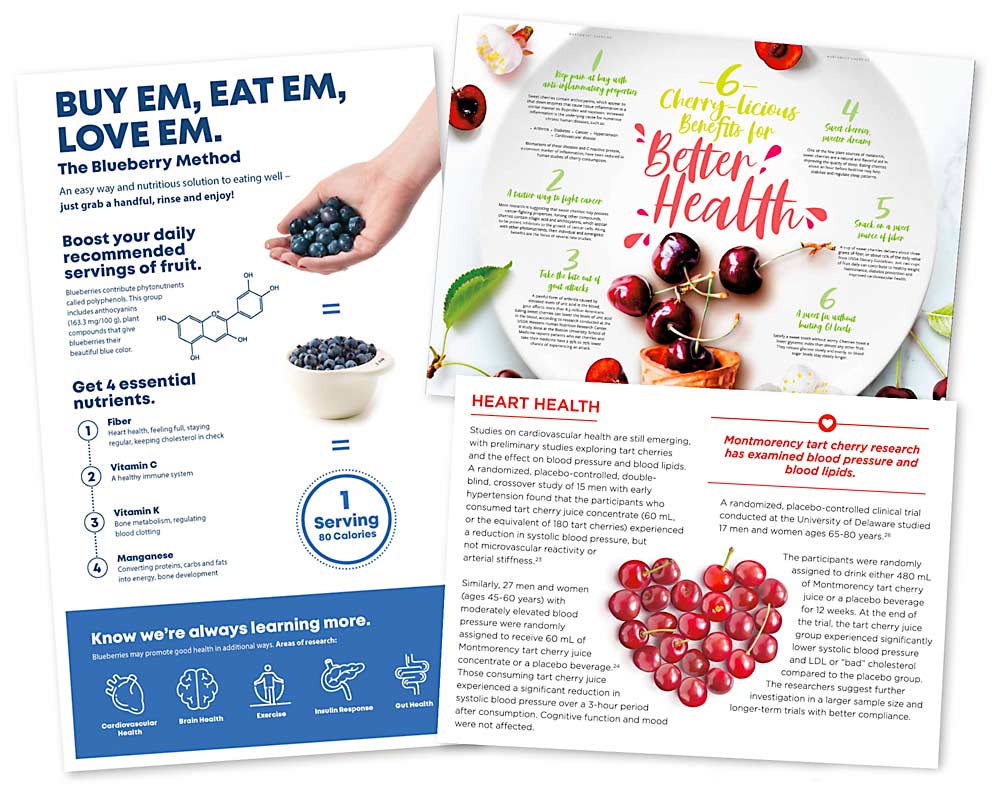
At the U.S. Department of Agriculture’s Western Human Nutrition Research Center in Davis, California, researchers are looking at how consumption of Bing sweet cherry powder might reduce the risks from metabolic syndrome — a broad suite of risk factors for heart disease, stroke and diabetes — and from chronic life stress and stress-induced cardiovascular reactions.
The research, funded in part by the sweet cherry industry, marks one of many produce industry-backed projects that provide the foundation for health-focused marketing efforts.
Like many crops, the sweet cherry, tart cherry and highbush blueberry industries have spent the past couple of decades funding research into the health benefits of their crops — and sharing the results to promote awareness and boost sales. Those long-term research and marketing efforts have dovetailed well with changing demographics and buying habits, helping to transform consumer perceptions along the way.
The messages also have proven to be particularly timely and relevant amid the global pandemic and increasing concerns about maintaining good health.

Sweet cherries
James Michael, vice president of marketing, North America, for Northwest Cherry Growers and the Washington State Fruit Commission, said the Northwest sweet cherry industry recently approved the largest promotions budget in its history, for 2021, with a particular emphasis on health benefits of cherries.
The industry has been funding cherry health research for more than 25 years and has built a growing library of health benefit claims. This meshed well with shifts in cherry-buying demographics. Traditionally, if you lived in an affluent urban or suburban area, you were nearly twice as likely to buy cherries. That metric still has weight, but today’s buyers are more interested in leading a healthy lifestyle, he said.
This year’s marketing emphasizes multiple health findings: Sweet cherries are a powerful anti-inflammatory, one of the oldest known cures for gout, low on the glycemic index and one of the few plant sources of melatonin. They lower blood pressure, boost the immune system and help people fall asleep easier, he said.
Michael mentioned two current research projects, both led by Texas A&M University nutrition researcher Giuliana Noratto, who began some of her efforts while temporarily at Washington State University several years ago. During the pandemic, she continued her lab research on breast cancer but had to postpone a study on how cherry consumption influences the gut microbiome. When Texas eased pandemic-related restrictions, Noratto was able to resume her feeding trial research. They hope to have early results from that study by next year, he said.
The industry realigns its health messaging every year, fitting it to the latest consumer trends. For example, a lot of consumers have put on extra weight during the pandemic, so now campaigns are emphasizing exercise recovery, Michael said.
The efforts seem to be working. According to 2020 research, 59 percent of consumers were influenced by the health benefits of cherries when making a decision to purchase. According to a 2018 survey, the two top health facts consumers knew about cherries were that they were fat-free and had anti-inflammatory properties. The industry received federal approval to promote anti-inflammatory properties in 2013.
“In five years, that’s a pretty successful reach,” Michael said.
Blueberries
The highbush blueberry industry’s newest brand positioning is “Grab a Boost of Blue.” The “blue” part is obvious: the berry’s unique color. “Grab” speaks to the berry’s convenience and versatility. “Boost” embodies its health benefits, said Jennifer Sparks, vice president of marketing and communications for the U.S. Highbush Blueberry Council and North American Blueberry Council.
Joanne Tehrani, director of nutrition communications with Padilla, the communications agency hired by USHBC, said the health message is woven throughout the blueberry industry’s promotional program. To see how the past 20 years of health research and marketing has changed consumer perceptions of the blueberry, all one has to do is look at the numbers: 98 percent of the media coverage the highbush blueberry received in 2020 mentioned its health benefits. In a 2019 survey, eight out of 10 registered dietitians said they always or frequently recommend blueberries to their clients; and last year, fresh and frozen blueberries set a record with $2.4 billion in retail sales, a 13 percent increase over the previous record set in 2019, Tehrani said.
Since 2000, USHBC’s research committee — made up of researchers, growers and marketers — has published 59 research publications, with 13 currently in the works. The greatest number of research papers have covered the areas of diabetes, heart health and brain health. Researchers are also exploring the links between blueberries and a healthy gut and how blueberries might potentially help prevent Alzheimer’s disease, Tehrani said.
Members of USHBC’s research committee and scientific advisory board evaluate the scientific soundness and potential public benefits of all research proposals. When a paper is about to be published, the marketing team develops a strategy to make sure the message will reach different audiences.
“We want our health professional partners to be aware of the latest science so they can give a wholehearted recommendation and communicate the science in a responsible way,” Tehrani said.
Tart cherries
Julie Gordon, president of the Cherry Marketing Institute, said the shift from marketing tart cherries as a traditional dessert ingredient to emphasizing their health benefits has created a tremendous amount of demand for and awareness of the Montmorency, the industry’s main variety, transforming it from a bakery ingredient to a “superfruit.”
The transformation has opened the door to new audiences as eating habits continue to change, making a crucial difference for the U.S. tart cherry industry during a period of increased competition from imports and a struggle to replace the buyers that abandoned domestic tart cherry purchases after the disastrous crop loss of 2012, she said.
“The campaign has changed the way people think about U.S.-grown tart cherries,” Gordon said. “If we’d have kept doing the same thing, I’m not sure where we’d be today with sales.”
Tart cherry growers voted in 2006 to create a national marketing initiative based on Montmorency’s health benefits, and the campaign was launched the next year. The industry had funded multiple research projects by that point and had the science to back up its health claims. Public relations firm Weber Shandwick and Jeff Manning, the creator of the “Got Milk?” ad campaign, were hired to oversee the initiative. Manning retired a few years ago, but Weber Shandwick is still running the campaign and focusing it on the latest trends, she said.
The marketing effort has given U.S. Montmorency tart cherries national recognition, something they couldn’t have achieved without the research the industry invested in to back up its health messaging, Gordon said. •
—by Matt Milkovich









Leave A Comment